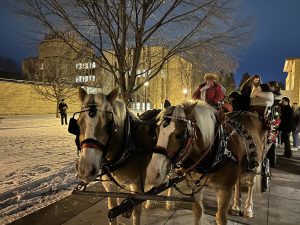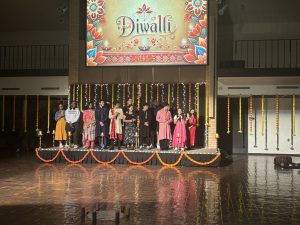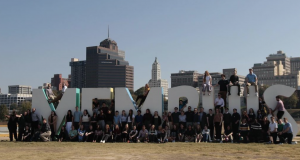
The scent of damp earth and growing things catches in your nostrils, circulated by the fans that hum at both ends of the new structure. April sunlight filters through the dual-ply plastic that puckers and billows in the wind, rattling like a snake: spring has come early to the high tunnel.
“[The season] has been great overall. I mean, it’s green, right?” said Joleen Baker, a garden intern. “Plants are growing; that’s what we want. You really can’t ask for much more than that.”
Samantha Hill, sustainability coordinator, has worked on the project since taking on the position in June. Facilities Management began construction began on the pentagonal gothic style building back in Aug. 2015, and the ribbon-cutting ceremony for the high tunnel was held Nov. 15 to commemorate its completion.
“It came from this big idea with a lot of different curveballs thrown at it,” Hill said. “It has been amazing to see how much the college has supported it. Seeing it slowly be integrated into the campus is really exciting because our main focus was, ‘How do we get this so that everyone can use this?’”
Located across the the townhomes and next to the soccer fields, the high tunnel is the first of its kind: it is an agricultural structure in a residential neighborhood on a college campus. There has never been anything like that in Moorhead, Baker said. For most of the winter, the high tunnel sat mostly unused, but on March 20 the interns started planting. This marks the high tunnel’s first growing season, according to Samantha Ferguson, a garden intern.
“It’s had its fair share of ups and downs, especially in the weather that we’ve been having recently because it’s been really warm and then it gets down to below freezing at night, so it is hard to keep the plants growing at a steady rate,” Ferguson said.
The plants that are currently in the high tunnel are cool-season crops, according to Baker. This means that they can stand getting down to around freezing. Cool-season crops include beets, radishes, carrots, and lettuce among others. Besides a few frozen beans, most of the plants have survived and are growing, proof that the high tunnel serves its purpose.
The high tunnel was built in order to extend the growing season of a traditional outside garden, such as that of the neighboring Cornucopia organic garden which is managed by student interns during the summer, into the academic year. This has allowed classes and students to go to the high tunnel and learn more about the food system, Baker said.
“This not only is a space for conversation, but also a place to get their hands dirty and learn a little bit more about growing food,” Baker said.
Currently classes must register by connecting with Samantha Hill, sustainability coordinator, in order to sign up for a time slot in the high tunnel. An online reservation system will eventually be put on Concordia’s website.
“There is a small core of faculty that has always been interested in sustainability, so those were the first that we reached out to,” Hill said. “We knew it was going to be a learning curve out at the high tunnel, so we wanted to just have a small subset of faculty and courses coming out and working in it, so that we could see how things went without being overwhelmed.”
Planting beds can also be requested through Hill, according to Ferguson. Several classes have planted in the high tunnel, setting up experiments and looking at plant growth.
“It’s just a good way to bring education out of the classroom and apply the skills that they learn in the classroom to something else,” Ferguson said. “I think it is really unique that we have that experience.
However, not all classes that come to high tunnel plant in the beds. The high tunnel has become a place for conversation, according to Baker. The garden interns had a class come in that had read a book called “The Year of the Flood” which focuses on food sovereignty in a post-apocalyptic world, so it is important to be able to grow your own food, Baker said.
“The garden and the high tunnel provided a really good area for that conversation to happen because this is one way that we can promote food sovereignty, maybe just on a small scale,” Baker said. “I also was in a class that came out and had a conversation about whether or not season-extension technology like this is viable for countries that are impacted by climate change.”
Concordia’s high tunnel is the Cadillac of high tunnels because, in addition to the greenhouse effect created by the plastic, there is also an in-ground heating system, Baker said.
The high tunnel has a solar collector, which is the big solar panel outside of the high tunnel. It collects heat from the sun and warms the air within the panel. Once that air reaches a certain temperature, a fan kicks on and shoots the air into a grid structure of tubes beneath the soil of the high tunnel, warming the soil, according to Baker.
Photovoltaic solar panels also sit on top of the head house, the building at the north end of the tunnel, and produce energy. Within the head house, a 3,000-gallon water tank takes up about a third of the building. The tank serves as a water source because, while there is an irrigation hook up out there, it gets shut off in the winter and does not get turned on again until mid-April — weeks after planting begins.
The large tank has notches so one can see the water level, which allows interns to be more aware of their water-use as a limited resource. The high tunnel also has two smaller tanks at only 300 gallons.
“It is going to teach [interns] water conservation techniques,” Baker said. “This summer we are also hoping to move the 300-gallon tanks outside and create a rainwater catchment system off the high tunnel to go into those 300-gallon tanks to feed the garden and the high tunnel.”
Beyond how much water is being used, the garden interns collect a variety of other data. According to Ferguson, interns monitor how much power is collected from the solar panels on top of the head house, the temperature in the high tunnel and the temperature of the soil.
Through a private grant, Hill was able to hire five interns, three more than the two that normally work during the summer on the garden. The extra hands were hired because Hill was not sure how much time commitment the high tunnel would require for this first semester. Furthermore, she wanted to make sure that she was not turning away people who were interested in the garden. Tyler Franklin, a part-time garden manager, was also hired.
“The interns range from various different aspects of majors on campus and also in different areas of knowledge in gardening or no knowledge at all,” Hill said. “We wanted to make sure that we weren’t just picking interns based on experience, but based on their passion to be involved out there, so we hired all five and we think it’s been going really well.”
The interns have split up their jobs into tasks that interest them. According to Baker, there is a data specialist, a tour-scheduling specialist, a budget person, an education outreach person and someone who is focusing on permaculture and planting techniques. The garden interns have weekly meetings to discuss and share information, make plans and ask questions, according to Ferguson, whose focus as an intern is marketing and outreach.
The interns can also direct their questions to Franklin. Franklin is a graduate of MSUM and he oversees the interns. Ferguson said Franklin is always aware of what is going on in the garden and serves as a valuable resource.
“I’m making the signs at the garden and I’m also planning events at the garden, so that it draws in community members, students and staff to the garden,” Ferguson said.
Recently Ferguson, along with the permaculture specialist intern, Kaya Baker, started Happy Harvesters Gardening Club. The club will serve as a hub for volunteers who want to be a part of the high tunnel and garden. Students, even if their courses are not involved with the high tunnel, will be able to volunteer through the club.
“We share information such as, ‘Hey, we are going to be harvesting this day, if anyone is interested, please come and join us!’ It’s a way to bring people together and build that sense of community around the garden, and that’s how Kaya and I framed it,” Ferguson said.
Baker came up with the idea after attending and connecting with students from other colleges at the Association for the Advancement of Sustainability in Higher Education conference, according to Hill.
The high tunnel has also been used to plant flats of seedlings, some of which will be used as demonstration gardens at Little Free Garden event, according to Hill. Several Concordia organizations have created Little Free Gardens, including Student Environmental Alliance, Eco-Reps, and Habitat for Humanity.
The Little Free Garden initiative was started by Ugly Food of the North. The group works to address food waste and build grassroots support for a sustainable Fargo-Moorhead food system through education, networking and community organizing, according to their Facebook page
This Saturday, Concordia is partnering with the group to hold The Little Free Garden event on campus from 9 a.m. to noon, according to Ferguson.
“It’s similar to the Little Free Library initiative, which, if you haven’t heard of that, is every so often on a block you’ll see this little nook or box on a stick that has books in it and you just open it up and take books and put books in as you please. So it’s going to be the same concept, but applied to a garden,” Ferguson said.
The example gardens will show people how a garden could look when it is done. Two weeks ago the interns planted the pilot gardens, so they are all ready to go for the event, according to Ferguson.
The Little Free Gardens themselves are 4-by-2-foot raised wooden beds that are to be put in front lawns and decorated however one wishes. Planting is also entirely up to choice, according to Ferguson.
“Then when something grows — say a tomato pops up — anyone could come by and cut it off and take it home with them. So it is building community and learning about food sovereignty and food security, especially in places that are food deserts and don’t have proper facilities for people to buy food,” Ferguson said.
Little Free Gardens empowers people to grow their own food, according to Ferguson. The Saturday build will bring in community members to create their own little gardens.
Even as outreach expands and other projects bloom from the high tunnel ideas, the interns have faced challenges and overcome obstacles. This first season has been a huge learning curve for all parties involved, especially since they are all new to the high tunnel, according to Baker.
“This is the first year that this is happening, and we’re all learning with the campus so the sort of hiccups that we come to — like how clean do we need to keep the head house for classes and how much communication do we have to have with professors — we’re all learning together for that.” Baker said. “The support that we are getting from the campus is amazing, and I hope that continues. And I hope that people continue with patience as we still try to figure this out.”
According to Baker, of all issues that have come up, the biggest thing that needs improvement is simply communication. Yet the challenges are also learning opportunities, and the interns are using the feedback that they receive to do better. It’s all a learning curve, according to Hill.
“We’re going to make sure that we don’t just cover up our failures, but we learn from them and we figure out what we can do differently next season that will help us to better succeed,” Hill said.
For Ferguson, being a garden intern has been a learning experience in and of itself because she has not gardened much in her life.
Ferguson has learned a lot from the other interns through working with them and asking questions. Some of her favorite moments this semester have been just sitting in the head house or high tunnel surrounded by the other interns who are all so passionate about growing plants.
“Knowing that I don’t need to learn from a professor or a teacher, that I can learn from people around me and use their experiences to help myself grow. Grow, no pun intended,” Ferguson said with a laugh, “That’s been very rewarding.”
Seeing plants grow has been rewarding for Ferguson as well. At times, she has felt that gardening was this far-off thing that she was not good at. In the past, Ferguson couldn’t keep a plant alive, but now she and the other interns have a whole garden of flourishing plants.
“There’s not really a trick to growing things. You just put it in the ground, and you water it a little and give it some warmth and sunshine, and it does its thing,” Ferguson said.
Hill has enjoyed seeing students become involved in the high tunnel as classes visit. Many are surprised to learn that Concordia has a high tunnel; some even find out that there is a garden on campus, but Hill encourages people to simply go out and visit the garden and high tunnel to see what is being planted.
“A big chunk of my work here is dedicated to the high tunnel, so I forget that some people aren’t as involved. It’s exciting when people say, ‘Guess what I saw today. We have a high tunnel!’” Hill said.
Hill, like Ferguson, has learned so much from the interns and Franklin. Everytime she goes out to the high tunnel, she learns something new, from how something needs to be planted to how often it needs to be watered.
“This is a secret, but I don’t know anything about gardening, which I feel like, as a sustainability coordinator, it is assumed that you have a green thumb,” Hill said. “I don’t.”
Pointing to the potted plant on her desk, she continued. “This plant, I think it is too big for its pot. But it’s alive and that’s happy for me.”
Hill also found it fascinating to learn about the technology of the solar collector and in-ground heating system.
“We took this high-tech technology and used it to do something as simple as thawing soil to be able to plant,” Hill said.
Just as the high tunnel has brought together high tech and simplicity, so too has it connected students with food and the food system. Baker has found it extremely gratifying to teach people how great it is to grow your own food and how rewarding that process can be.
“I love growing food so much,” Baker said. “My favorite part is the fact that I can come out here and I can be in an area where I can grow food, and I can teach others to grow food because that’s my favorite thing to do in life. That’s my passion is to teach others how to grow food and the importance of doing that.”
Baker loves seeing the looks on people’s faces when they sow seeds or harvest for the first time. According to her, our culture has become so detached from food and the food system that we don’t often get to use food as a way to bring people together.
“This high tunnel and getting to work with the interns and getting to work with the classes has really restored my faith in our ability to improve our food system and to get people back into that,” Baker said. “Food is the one thing that we all have in common.”






Be First to Comment